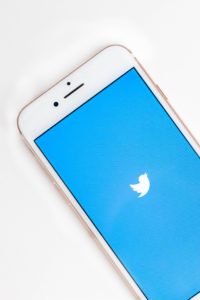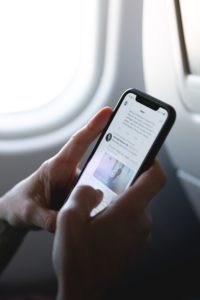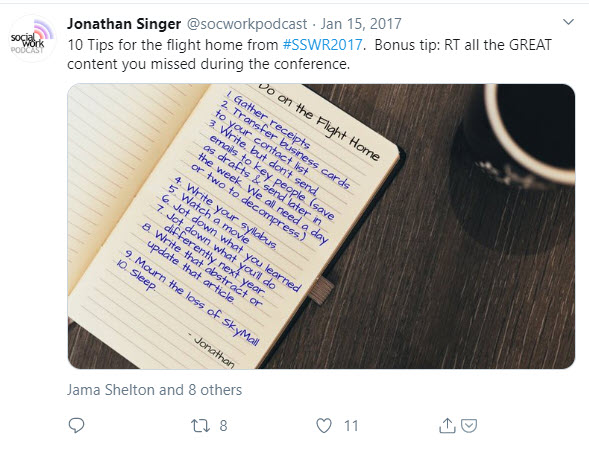Using Twitter at a Professional Conference
Editor’s Note: This post is one in a series about how technology can be used to develop and sustain one’s professional network. The idea for this post came from a think tank hosted by the University at Buffalo’s School of Social Work in June 2019, looking for a way to teach students in their new online Doctorate of Social Program (DSW) program about how to develop key stakeholder networks in relation to a substantive topic area. In this series, we are exploring the concept of a Professional Collaboration Network (PCN), which are technology-mediated user-centered relationship constellations designed to enhance or enrich connections, knowledge, and professional opportunities. This post covers the use of Twitter at professional conferences as a way to share your insights and extend the reach of the conference sessions.
This is the fourth blog post in a series on using Twitter to create Professional Collaboration Networks (PNCs). Previous posts included:
- What is a Professional Collaboration Network (PCN) & why do you need one?
- Twitter for your Professional Collaboration Network (PCN)
- How do you do relational Twitter?: Developing your Professional Collaboration Network

In this blog post, we discuss how Twitter can be used at a professional social work conference. There are at least two important reasons why tweeting at conferences is a valuable practice. First, attending conferences requires resources and time. Not everyone has the ability to attend all conferences, and one person certainly cannot attend all of the conferences that interest them. By tweeting from a conference, participants can share what they learned in sessions with anyone who is interested. Not only does this extend the reach of the knowledge shared at a conference, it makes content accessible to individuals and groups who might not be able to attend. Curating all the tweets from a conference can create an informal transcript of the happenings at a conference from multiple points of view. Second, tweeting at a conference allows an individual another way to network and meet people. Creating a public list of individuals and groups on Twitter who are attending the conference can supplement a stack of business cards and allow you to engage with more people during and after the conference. Alternatively, if you can’t attend a conference, you can follow the tweets of users who are at the conference and reply with your questions. There are even some conferences that occur only on Twitter (check out @Biotweeps).Third, it can increase your visibility in a particular subject area. For example, if you are presenting at the conference, you have the opportunity to share a photo and information from your session. The suggestions in this post come from the real life experiences of the authors as well as recommendations gleaned from articles written about conference tweeting.
Before the Conference
Learn the conference hashtag. The first thing to know about tweeting at the conference is the conference hashtag and Twitter handle. When some of us started using Twitter at conferences, hashtags were not common. However, most regional, national and international conferences now have a hashtag, which is a descriptive term with the # symbol that should be used in every tweet related to the conference (for more information about hashtags, see our previous article about Twitter). For example, if you are attending a conference about veterinary social work in 2020, the hashtag could be #VetSWKConf2020. TheTwitter handle representing the National Society of Veterinary Social Workers might be @VetSWKSociety. Typically, the conference hashtag changes from year to year to represent the year of the conference, and the Twitter handle remains the same. You can typically find the hashtag on the conference’s promotional materials or by following the organization’s Twitter account. If the conference has not developed a Twitter hashtag, you can propose one as a participant by tweeting about it.
Two to four weeks before a conference. Go online to see what the conference organizers and others are saying about the conference. Tell your followers that you plan to attend the conference and the sessions you are attending. If presenting at the conference, this is a great time to share information about your session or poster by tweeting the topic, location and date/time of your session. Include a photo of your slide deck or poster. Reply to others who are tweeting about the conference as well. For example, a colleague from another institution might be tweeting about their presentation which is at the same time as your presentation. You could reply that you are disappointed to miss their session, and ask that they share the highlights or see if someone else will tweet from your colleague session. If you think you will be really busy during the conference and it will be hard to tweet, you can pre-schedule some tweets about your session using a service such as Hootsuite. For instance, you can schedule a tweet to post 15 minutes before your presentation about the topic and location.
Start following other Twitter users who are planning to attend the conference. This is also a good time to create a public Twitter list of people and groups attending the conference. For information about how to create a list on Twitter, see our earlier blog post. One of us (Laurel) likes to create a list for every conference using the conference hashtag in the title and then adding anyone tweeting with the conference hashtag to the list. This creates a filtered list as well as a contact list that can be used after the conference. Consider tweeting the list to the conference organizers with the conference hashtag, inviting others to follow your list or ask who wants to be added.

During the week of the conference, make sure you are regularly checking the conference hashtag to get updates about the conference location, weather, and other tips for the conference experience. Many people like to send tweets while traveling to the conference and when they arrive so they can connect with colleagues right away. This might include photos from the airplane or the hotel balcony.
Plan your tweet-ups and other opportunities to connect in real life. One of us (Jimmy) saw other academics tweeting during conferences were happy to meet with early career faculty, practitioners, or even students to lend a listening ear or simply provide some advice. Here is what he said about connecting his digital network with his in-person network:
“I decided to try this at an upcoming social work conference, and had an individual I’d only met on Twitter take me up on the offer. We connected via Direct Message and met up in the lobby where we discussed research interests, backgrounds, graduate student life, the academic job market, and so much more. I feel like this was the best part of the conference because even if I didn’t have the answers, it was just a great opportunity to engage in some informal mentoring and meet a new friend and colleague. Don’t be shy about reaching out to Twitter colleagues for a coffee meet-up!”
During the Conference
Understand and follow the conference etiquette. Make sure you understand the conference guidelines for using Twitter. Most conferences will put a short blurb in the program about the social media policy. Some conferences have an open policy when it is okay to tweet anything including photos from presentations. Others might have an opt-out policy, where individual presenters request no tweeting during their sessions. If you are unsure, ask the presenters if it is ok to post images of them and their slides. If you are presenting, be sure to let people know if it is okay to tweet or not. Additionally, be respectful and professional when tweeting even if you disagree with a presenter’s work.
Use the conference hashtag in every tweet. This is the most important thing you can do while at the conference because the hashtag is what other users will be searching for and following while on Twitter. If you don’t use the conference hashtag, it is like you are talking about the conference but no one is listening to you. If you do only one thing on Twitter at a conference, it should be using the conference hashtag when tweeting.
Tweet about the sessions you attend. Listen carefully and pick your words wisely. Consider doing a direct quote from the speaker that includes their Twitter handle (if they share it) or name in the tweet. Alternatively, you might tweet about a key takeaway or your top three highlights from the session. Adding your thoughts about how the presenter’s scholarship relates to your own teaching and scholarships increases the opportunities for dissemination for everyone involved. If you’re taking pictures of the presenter, get their Twitter handle and tag them in the photo.
Listen for the soundbites. The first person to tweet a hot quote will get the most retweets. Don’t just say “at a session”- listen for something interesting or thought provoking to share that will get other individuals’ attention. Take it a step further by making the quote a text image in an app like Canva. Tweets with images tend to get more retweets.
Include interesting photos, GIFs and links in your tweets. Tweets with visuals grab more attention and also allow you to tag other users to the photos which will expand the reach of that tweet.

Take pictures of folks attending the conference. This isn’t 21st century selfie narcissism. It is about sharing and recording what happens at the conference. People LOVE to retweet conference photos. If available at a conference, stop by the social media booth, often located near registration, or in the conference exhibit call to snap a pic in front of the backdrop!
If you are a presenter, send a tweet right before your session with location & topic. Share your enthusiasm. Include your Twitter /Instagram handles on your first and last slide and handouts of your presentation. Let your audience know if they can or cannot tweet about your session/ post photos of your slides.
Keep it positive. Twitter is not the place to take issue with methods or other concerns related to the presentation- do that in person. Use Twitter to promote outcomes you agree with. Lift your colleagues. Support their good work.
Try live tweeting a session. This involves tweeting key points throughout a presentation, almost like a transcript of the session. This involves speed and lots of concentration so here are some tips:
- Prepare in advance. Know the title and abstract of the session. Prepare points about relevant reports/statistics or links to evidence related to the discussion.
- Build a Tweet Bank: Take the time before the event by researching the presenters and creating a digital document with possible verbiage for tweets, including the Twitter handles of relevant people, institutions and hashtags to include in your tweets.
- Get there early for a good seat. You want to sit in the front where it is easier to listen and capture good photographs. Choose an aisle seat so easily take pictures without disturbing those around you.
- Keep your phone fully charged: Taking photos and live tweeting will drain your battery. Make sure your device is charged and carry a portable charger with you.
- Relate to your work and scholarship. Live tweeting is not just for sharing others’ research and ideas, but also a way to connect your own work to the public conversation. Try connecting a tweet about the conference to a follow-up tweet related to your own work such as a link to an article or blog post.
Check out this podcast from The Social Work Podcast about how to live tweet as a team at a conference, Here’s Tweeting at You: Using Social Media to Expand the Reach of Academic Conferences.
Follow a conference from home
Following a conference from home, or anywhere, involves many of the Twitter practices written about here and in our other blog posts. Setting up lists, following the conference hashtag, or even using specific applications to follow along can help you engage from anywhere. Being relational can be just as important when following along at home as it is to be professional with your conference engagement via Twitter. Retweeting, favoriting, and commenting on certain presentations can make it seem as if you are actually in attendance.
After the Conference
Tweet a good post-conference reflection with a photo that details a checklist of ideas and action items. In the photo below, Jonathan Singer offers some really good tips that coincide with what we have written here (well, except for the SkyMall piece), but it is important to connect with others post-conference on Twitter and off to help build your PCN.

Archive your tweets. There are a few ways to curate your tweets. Try creating a Twitter Moment, which is a built in tool in Twitter designed for digital storytelling. You could also create a digital transcript in a third-party application like Wakelet.
Check out the Twitter analytics from the conference. Twitter provides you each user with their analytics, which is a dashboard that shows the activity of your tweets and how you engaged with others on the platform. You can logon to your dashboard at: https://analytics.twitter.com/. There you will find information about impressions (the number of times a tweet is seen by other users) and engagement (the number of times a user interacted with one of your tweets.
Additionally, the conference may have registered its hashtag with Symplur’s Healthcare Conference Hashtags, a free platform that tracks health-related conferences and chats on Twitter. This platform will provide basic analytics for a hashtag as well as options for creating a transcript of tweets.
Follow-up on connections & content from tweets. Once you get back to your home institution, review the tweets from the conference, especially with the lens of your own scholarship. If you have a blog, you may want to post some of your key take-away insights. Look for connections and/or gaps related to your own scholarship. Check out Jessie Daniel’s blog post titled From Tweet to Blog Post to Peer-Reviewed Article: How to be a Scholar Now for inspiration on how to leverage information learned at conferences into published works.
You might also want to look at who is retweeting your Twitter posts and see if there are opportunities to connect within and outside of academics. Reach out to those individuals and work to develop a professional relationship. A recent article about academic information on Twitter found that people tend to leverage social connections on Twitter when searching for information rather than scrolling through tweets (Mohammadi, Thelwall, Kwasny & Holmes, 2018).
How do you use Twitter at conferences? Please share your thoughts or questions in the comment section below.
References
Mohammadi E, Thelwall M, Kwasny M, and Holmes KL (2018) Academic information on Twitter: A user survey. PLoS ONE 13(5): e0197265. https://doi.org/10.1371/journal. Pone.0197265
How to cite this post:
Hitchcock, L.I., Bakk, L., Michaeli, D., Young, J.A., Sage, M. & Smyth, N.J. (2020, March 12). Using Twitter at a Professional Conference [Blog Post]. Retrieved from Teaching & Learning in Social Work website: https://laureliversonhitchcock.org/2020/03/12/using-twitter-at-a-professional-conference/


